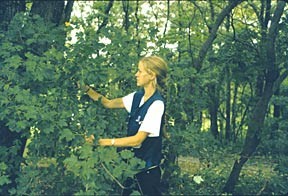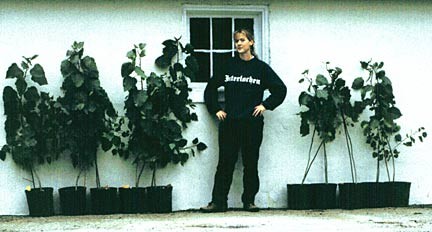City-grown air pollution is tougher on country trees
By Roger Segelken
A tree grows in Brooklyn — despite big-city air pollutants. Meanwhile, identical trees planted downwind of city pollution grow only half as well — a surprising finding that ecologists at Cornell University and the Institute of Ecosystem Studies (IES) reported in the current issue of Nature (July 10, 2003). They attribute the effect to an atmospheric-chemistry "footprint" that favors city trees.
"I know this sounds counterintuitive but it's true. City-grown pollution — and ozone in particular — is tougher on country trees," says Jillian W. Gregg, lead author of the Nature cover article, "Urbanization effects on tree growth in the vicinity of New York City." Other authors of the Nature report are Clive G. Jones, an ecologist at the Institute of Ecosystem Studies in Millbrook, N.Y., where some of the field studies were conducted, and Todd E. Dawson, professor of integrative biology at the University of California, Berkeley, and a professor at Cornell when the study began.
Gregg was a joint Cornell/IES graduate student, pursuing a Ph.D. in ecology, when she started planting identical clones of cottonwood trees (also known as poplars, or by the scientific name Populus deltoides ) in and around New York City. Test sites included the New York Botanical Garden and the Hunts Point water works in the Bronx; a Consolidated Edison fuel depot in Astoria, Queens; as well as Long Island's Brookhaven National Laboratory in Upton; Eisenhower Park in Hempstead; and the Cornell Horticultural Research Laboratory in Riverhead. About 50 miles north of Manhattan, in the Hudson River valley, she also planted cottonwood clones at the Millbrook institute.
One aim of the study was to show the impact on plants of a tough life in the city, where a variety of gaseous, particulate and photochemical pollutants from fossil-fuel combustion bombard plants as they struggle to grow in heavy metal-laden soils. The fast-growing poplars were to serve as a kind of "phytometer" to gauge the net effect of urban and industrial pollutants on urban and rural ecosystems.
For three consecutive growing seasons Gregg returned to the sites to plant cottonwoods, harvesting them to weigh their biomass and to perform other kinds of analyses. She controlled for differences in light, precipitation, season length and soil factors, making air quality the primary factor of concern. The experimental cottonwoods growing in Queens and the Bronx "breathed" the same pollutants as did other plants (and people) in the boroughs. So did cottonwoods along the Hudson and on Long Island.
Unexpectedly, the city trees thrived. As reported in Nature, "…urban plant biomass was double that of rural sites." But in some areas of metropolitan New York City, as well as in other polluted cities, Gregg and her colleagues have found "footprints" of lower-than-expected ozone exposures. As Gregg explains the facts of atmospheric chemistry in the city, "Ozone is what we call a secondary pollutant. So while the primary precursors for ozone are emitted in the city, they must act in the presence of sunlight, over time, before ozone is formed. By then, the air mass has moved to rural environments."
The Big Apple air situation is even more complicated, Gregg notes, because the city is downwind from New Jersey, another densely populated and industrialized region. "A lot of the ozone moving into New York City was formed in the so-called Garden State," the ecologist says. However, the reactions of ozone formation are cyclical, with the presence of one of the primary precursors, nitric oxide (NO) — which occurs in high concentrations in the urban atmosphere — destroying ozone once it has formed. As new NO compounds develop, three-atom oxygen is reduced to the more benign, two-atom kind.
Ironically, NO concentrations are very low in most rural areas, so ozone remains in the atmosphere there and plants' exposure period to the harmful gas is extended. (Although one-hour peak ozone exposures can be high in urban centers, exposure periods last longer in rural environments, resulting in higher cumulative exposures.) Trees and other plants growing within the lower cumulative ozone exposures of the urban-ozone footprints benefit from the NO scavenging reactions that reduce the ozone-exposure period. Trees growing in the purportedly clean rural areas aren't so lucky.
Berkeley's Dawson says results of the study have important implications for understanding the effects of urbanization on not only plants, but life in general: "As cities continue to expand with the growing human population it seems likely that their impacts will reach far beyond the city limits. We can add this new impact to a growing list of concerns about how humans and the pollution they create will continue to shape our planet," according to the integrative biologist. "You can no longer assume that if you move away from the city, like many people do, that you will escape its impact. If plants show depressed growth in rural areas where ozone peaks, we have to wonder what influence such pollution has on humans."
The study was supported, in part, by the U.S. Environmental Protection Agency, the Edna Bailey Sussman Fund for Environmental Internships, the New York State Heritage Foundation, the Mellon Foundation , Cornell's Department of Ecology and Systematics, the Institute of Ecosystem Studies, the Cornell Center for the Environment and Sigma Xi.
Media Contact
Get Cornell news delivered right to your inbox.
Subscribe
